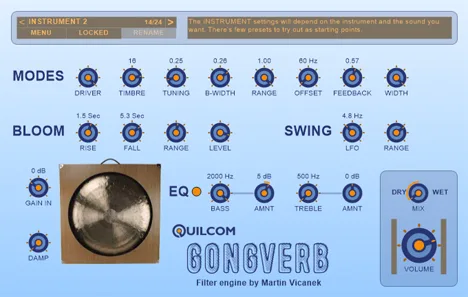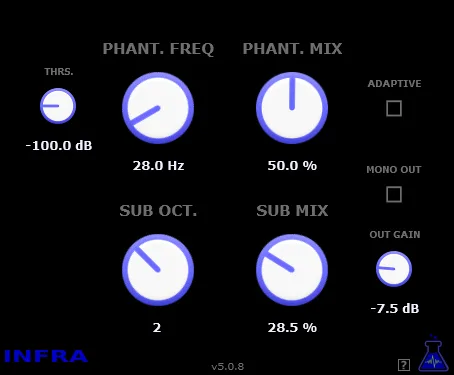GONGVERB by Quilcom: Delving into Unpredictable Echoes
What is GONGVERB?
GONGVERB by Quilcom isn’t just another reverb plugin. It’s an experimental sound tool, created for those who seek to go beyond conventional processing and discover new horizons in sound design. Developed as an effect version of the SIM-CHAU instrument, GONGVERB has reinterpreted it in the context of spatial processing.
It’s important to understand: GONGVERB is not a universal studio reverb for creating classic spaces. Its strength lies in its unpredictability and ability to generate unique, often strange and unusual echoes that can radically change the character of any sound. It’s a “toy” for sound experimenters, a tool for creating atmospheres, textures, and effects that are difficult to achieve with traditional methods. Its “experimental nature” manifests in how it reacts to the input signal, creating resonances and reflections that resemble something between an echo in a strange metallic space and the vibrations of a giant gong.
Why should you try GONGVERB?
If you’re looking for something that can inspire new ideas and add originality to your tracks, GONGVERB can be an interesting addition to your arsenal.
Features that make it unique:
- Experimental nature: Prepare for surprises. GONGVERB doesn’t always behave as expected, and that’s its main appeal. It can generate resonating “tails”, metallic overtones, or break down into strange harmonics.
- Not a “serious” reverb: This openness from the developer is a big plus. You know that you are getting not a plugin for room simulation, but a tool for creative chaos.
- Perfect for sound design: Need to create an atmosphere of the other world, add a strange metallic chime to drums, or transform vocals into a scattering of shimmering echoes? GONGVERB can be your secret ingredient.
- Inspiration for musicians: Sometimes one unusual effect can become the starting point for creating a composition. Experiment with different instruments – the result may surprise you and inspire new musical decisions.
How to use GONGVERB?
GONGVERB is a plugin for the bold. Don’t be afraid to turn the knobs and listen to the result. It’s perfect for insertion on individual tracks and can also be used on Send buses to create a unique spatial effect.
Tips for experiments:
- Start with simple sounds: Run a short percussive sound or a single synthesizer tone through GONGVERB. Listen to how it shapes the echo.
- Try it on different instruments: Vocals, guitars, synthesizers, drums, percussion – each instrument will sound different.
- Mix with the original: Use the Mix control (or on the Send bus) to find the balance.
- Automate parameters: Try automating some parameters throughout the track. This can create moving soundscapes.
- Combine with other effects: Add distortion, filters, chorus, or flanger before or after GONGVERB to create more complex textures.
GONGVERB is a tool for creativity, not for accuracy. Allow yourself to experiment and discover new sounds.
Technical details
GONGVERB is available in VST format for Windows operating systems (32 and 64 bit). This makes it compatible with most modern DAWs on this platform.
Developed by Quilcom, this plugin is an example of how independent developers create interesting and original tools that add diversity to the world of music software. It is part of a collection of plugins from Quilcom.
Conclusion
GONGVERB by Quilcom is an exciting, albeit unconventional, reverb plugin that opens the door to a world of experimental sound. If you are looking for a way to add unique textures, unusual spatial effects, or simply experiment with sound, this plugin is worth a look. It won’t replace your main reverbs for realistic spaces, but it will become a valuable tool for creative sound design and finding new inspiration. Download it, play with it, and maybe you’ll discover sounds you never even suspected existed.



